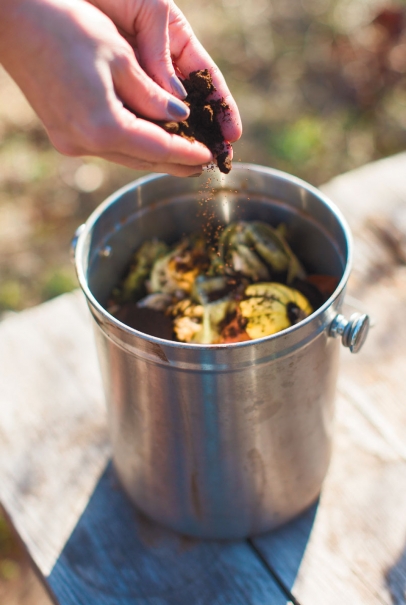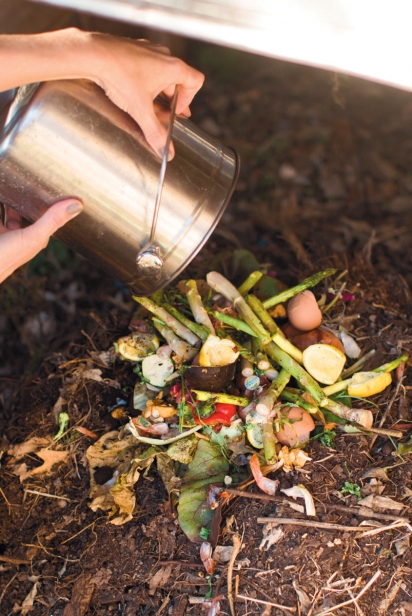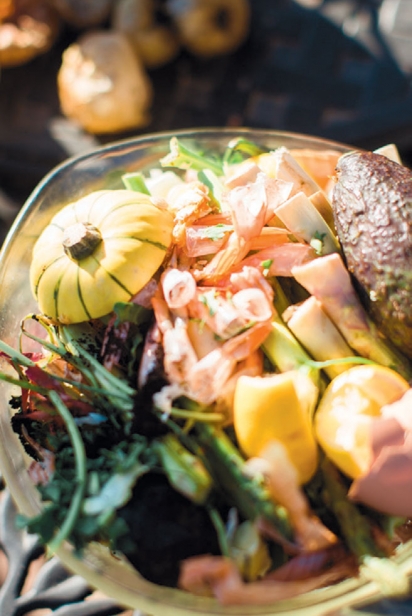Composting 101
Your Garden’s Essential Multi-Vitamin
There are four basic principles to maintaining a healthy composting system: nitrogen, carbon, heat, and oxygen. The ratios of nitrogen to carbon should be kept in balance to varying degrees, but typically a little higher in carbon-rich materials. This includes dry matter such as dead branches and stems, dry leaves, peels, sawdust, brown paper, coffee grounds and filters, conifer needles, straw, ashes, egg shells, corn stalks and silk, husks, and even peat moss. This element aerates the pile and gives it a fluffy quality because the materials are dry and crumbly. Nitrogen comes from green, living things and is high in essential proteins. This includes green lawn clippings, green leaves and plant matter, raw food scraps, spoiled fruits and vegetables and organic manures. These materials make necessary enzymes and provide moisture that creates heat needed to drive the temperature of the compost up as it decomposes correctly. When nitrogen is mixed with the right amount of carbon, this makes a nice loamy compost which is ideal for all plants. Too much nitrogen makes a soggy, smelly mess and slows down the decomposition process dramatically. Excessive nitrogen can also burn plant surfaces and root systems as it has an acidic pH, whereas carbon is alkaline. Always amend any nitrogen with an equal part carbon. Keeping dry leaves on hand is an easy way to always have some available since accumulating nitrogen is typically easier.
LET’S BUILD
Now that you know about the basics materials suitable for composting, you’re ready to get started! Always begin a new pile on bare earth. This introduces existing soil organisms into the pile which, like earthworms, will help aerate the materials, accelerate decomposition and leave behind their own little contributions. You can put a bed of straw or branches down first in order to assist with drainage and run-off, though you will need to water the pile in the summer when climates are dry. Typically, there is enough rain during the spring and fall to take care of that. Turn the entire thing from bottom to top every couple of weeks. You want to keep the new material covered and co-mingling with the older material. Covering the pile with plastic sheeting or a wood panel helps retain heat and moisture. It also keeps weed seed out.
Compost tumblers are helpful but certainly not necessary. They take care of covering, aeration and heat by enclosing the compost but they are also big and can be expensive. Homemade compost bins can be done with simple materials. A large plastic trash can can be used by drilling holes in the bottom, but turning can be difficult with this method. This is sometimes helpful though for small spaces. A simple bin can be made using wooden pallets that are available and inexpensive at garden centers and hardware stores. A modest pile for a household garden does not need to be very big. A 4x4 space is plenty for basic, residential use. It is a good idea however, to have a second pile going that is a little further behind so that you always have some working when you need to use the other one. You should have very pleasant, earthy smelling compost in about 3 months with regular care.
If you notice that it is not breaking down very quickly, a store-bought compost accelerator can be useful. This is usually a granule that is dissolved in a watering can and poured on. It’s like giving the compost a jump if the ratios become out of balance. Use your compost like a multi-vitamin for the garden soil. It’s a supplement that improves the health of pre-existing soil. Amend your beds about every 3 months with big heaps around the base of bedding plants, trees and shrubs. It is especially useful with new plantings. You will see the health of your garden improve, your edibles flourish and your flowers sing! Composting is a simple, sustainable practice that reduces methane in landfills, reduces our kitchen cookprint and minimizes the excessive energy spent on collecting trash that has not been responsibly separated. By separating your compostables and your recyclables, you will have very little trash coming out of your kitchen, which saves money and is gentle on the environment.







